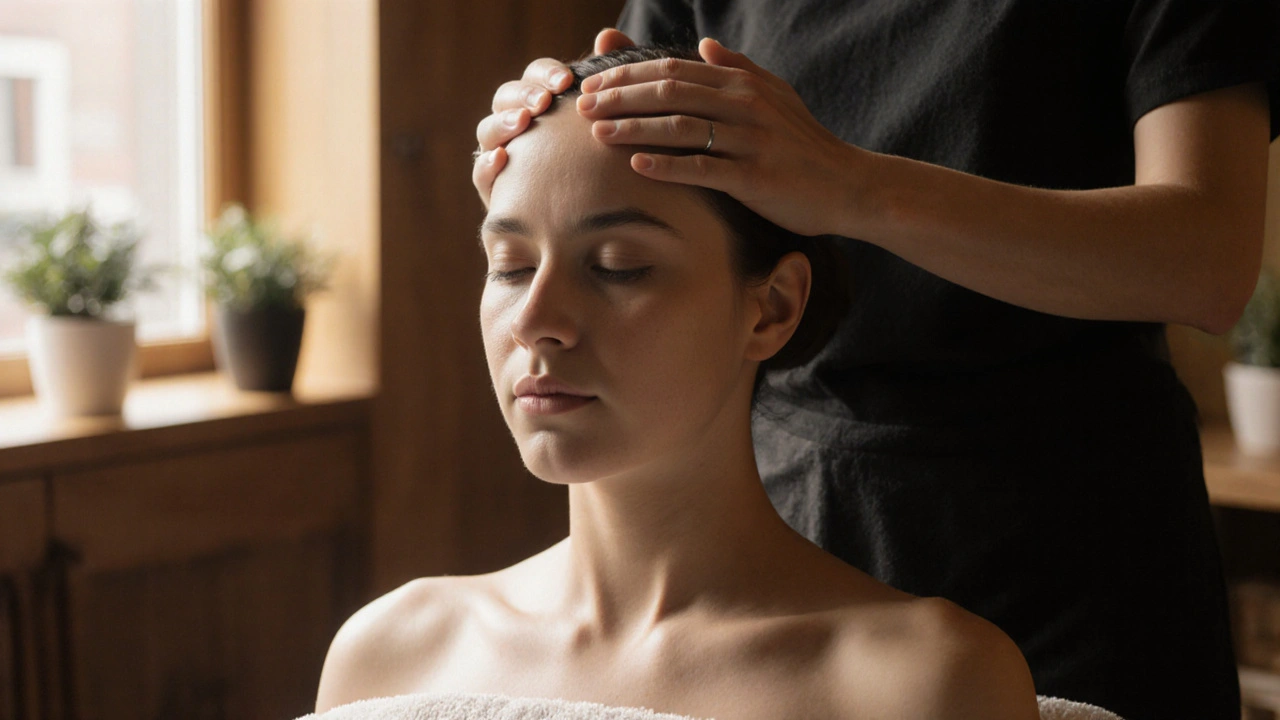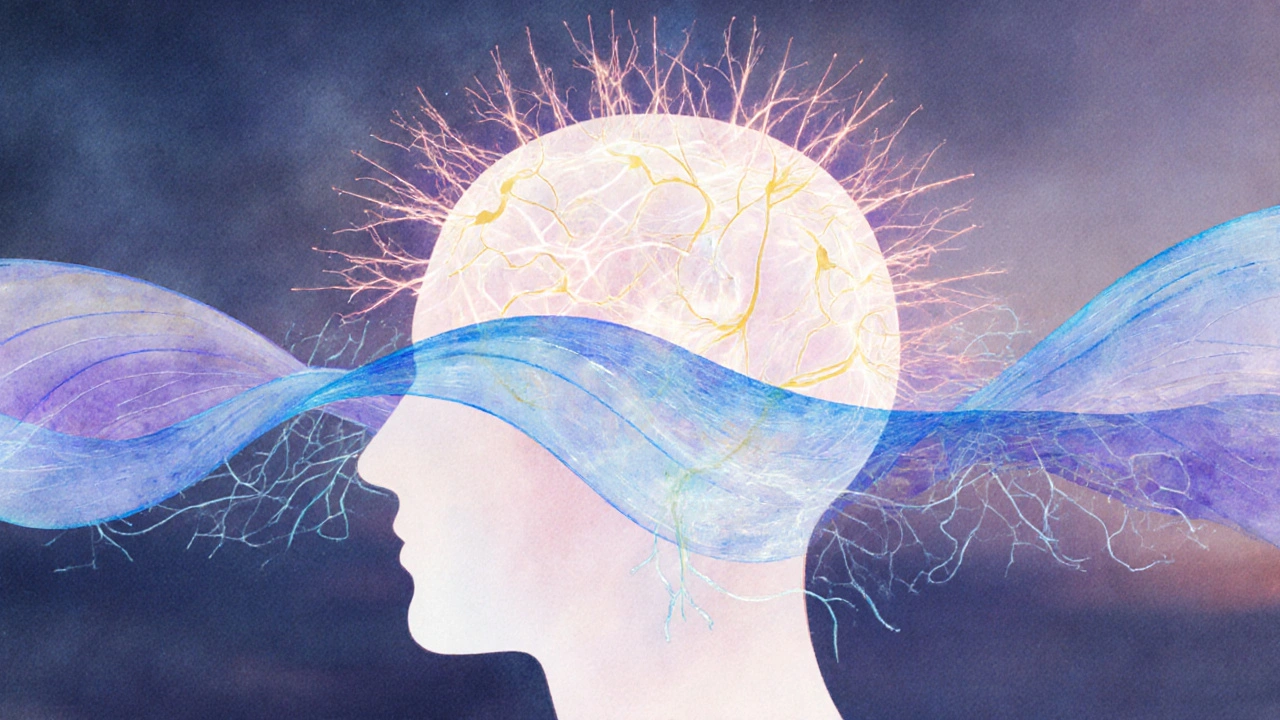Head Massage: An Unexpected Ally in Managing Chronic Pain

You’ve probably had one of those days-your neck feels like concrete, your temples throb, and no amount of coffee fixes it. You reach for painkillers, scroll through sleep apps, or stare at the ceiling hoping the pressure will just… go away. But what if the answer isn’t in a pill or a screen, but in your hands-or someone else’s-gently working on your scalp?
Head massage isn’t just for spa days or luxury treatments. For people living with chronic pain-especially tension headaches, migraines, or neck-related discomfort-it’s one of the most underrated tools available. And it’s not magic. It’s science.
Why Your Head Hurts (And Why Massage Helps)
Chronic pain in the head and neck isn’t usually one big injury. It’s the slow build-up of tension. You hunch over a keyboard. You clench your jaw during stress. You sleep funny. Your muscles tighten. And over time, those tight muscles pull on the sensitive nerves around your skull. That’s when you feel the dull ache behind your eyes, the pressure at your temples, or the stabbing pain that feels like a vice grip.
Here’s the thing: your scalp has over 100,000 nerve endings. It’s one of the most sensitive parts of your body. When you apply gentle pressure to that area-using fingertips, thumbs, or even a soft brush-you’re not just rubbing. You’re signaling your nervous system to calm down.
Studies from the Journal of Alternative and Complementary Medicine show that regular head massage reduces cortisol levels (your stress hormone) by up to 30% in people with chronic tension headaches. It also increases serotonin and dopamine-your body’s natural painkillers and mood boosters. In one 2023 trial, participants who received twice-weekly head massages for six weeks reported a 45% drop in headache frequency and intensity.
How Head Massage Differs from Other Pain Treatments
Most people turn to medication first. Ibuprofen. Acetaminophen. Sometimes even prescription muscle relaxers. Those help-but they treat symptoms, not causes. And long-term use? That brings its own risks: liver strain, stomach issues, dependency.
Head massage? It’s the opposite. It doesn’t mask pain. It rewires how your body responds to it. Think of it like hitting a reset button on your nervous system. You’re not just relaxing your scalp-you’re loosening the grip of the trapezius and suboccipital muscles that have been pulling your head forward for years. That tension? It’s often the real source of what you think is a “headache.”
And unlike physical therapy or chiropractic work-which can feel clinical or intense-head massage is gentle, quiet, and deeply calming. You don’t need to undress. You don’t need to lie on a table. You can do it sitting in a chair, even at your desk. It’s accessible. It’s immediate. And it’s free-if you know how.
What a Head Massage Actually Feels Like
Picture this: you’re sitting in a dim room. Soft music plays. A therapist’s hands rest lightly on your temples. Slow circles. Then, gentle pressure沿着发际线,从额头到后颈,像潮水一样缓缓移动。没有油,没有 loud music, no forced relaxation techniques. Just steady, rhythmic touch.
At first, you might feel a slight ache-especially if your scalp is tight. But within minutes, that sharp edge softens. Your breathing slows. Your shoulders drop. You might even drift off for a few seconds. That’s not laziness. That’s your parasympathetic nervous system kicking in-the part that says, “We’re safe now.”
Most sessions last 15 to 30 minutes. You stay fully clothed. No oils. No nudity. Just hands, skin, and time. It’s not a full-body experience. It’s focused. Precise. Like tuning a guitar string-just enough to bring it back into harmony.
Types of Head Massage You Can Try
Not all head massages are the same. Here are the three most common-and effective-styles:
- Scalp Massage (Ayurvedic Style): Uses firm circular motions with the fingertips. Focuses on pressure points along the scalp, especially near the crown and temples. Often done with light coconut or sesame oil. Best for tension headaches and stress.
- Shiatsu Head Massage: Based on Japanese pressure-point therapy. Uses thumbs and palms to apply targeted pressure along meridians that connect the head to the neck and shoulders. Helps release deep muscle knots and improve circulation.
- Reflexology Head Massage: Based on the idea that the scalp mirrors the entire body. Pressing certain zones (like the area above your ears) is believed to affect organs like the liver or kidneys. While the science is debated, many report reduced pain and improved sleep after sessions.
In Amsterdam, you’ll find all three styles offered in wellness centers, holistic clinics, and even some yoga studios. Places like De Stilte in De Pijp and Yoga & Wellness near Vondelpark specialize in these techniques.

How to Find a Good Head Massage Therapist in Amsterdam
You don’t need a fancy spa. You need someone who understands anatomy-not just relaxation.
Start by looking for therapists certified in Swedish massage, Shiatsu, or Ayurveda. Avoid places that push “romantic” or “body-to-body” services-that’s not what you’re here for. You want clinical precision, not vibes.
Check reviews on Google or Trustpilot. Look for keywords like “tension relief,” “migraine help,” or “didn’t feel rushed.” A good therapist will ask about your pain pattern: “Where does it start? Does it move? Does stress make it worse?” If they don’t ask, walk away.
Try booking a 20-minute session first. Most places offer short sessions for under €30. That’s cheaper than a coffee shop latte and far more effective.
What to Expect During Your First Session
You’ll sit in a comfortable chair. The therapist will drape a warm towel over your shoulders. They’ll start at your forehead, using the pads of their fingers to make slow, circular motions. No sudden movements. No cracking. No pressure that hurts.
You might feel a few tender spots. That’s normal. Tell them. They’ll adjust. Around the 10-minute mark, you’ll likely feel warmth spreading from your scalp down your neck. That’s blood flow returning. That’s your body healing.
Some people cry. Not because it’s sad-because it’s the first time in months they’ve truly relaxed. Others fall asleep. Both are fine. This isn’t a performance. It’s a reset.
Cost and Booking: No Surprises
In Amsterdam, a 20-minute head massage typically costs between €25 and €40. A full 45-minute session runs €50-€70. Many places offer package deals: 5 sessions for €200. That’s less than €40 per session.
Booking is easy. Most studios let you book online through their website or via WhatsApp. Look for places that offer “head-only” or “neck and scalp” options. Avoid full-body packages unless you want the whole thing.
Pro tip: Book your session in the late afternoon. That’s when tension peaks. You’ll leave calmer, and your evening will feel lighter.

When to Avoid Head Massage
It’s safe for most people-but not everyone.
- Don’t do it if you have open wounds, recent surgery, or an active skin infection on your scalp.
- Avoid if you have uncontrolled high blood pressure or a recent head injury.
- If you have migraines triggered by light or sound, ask for a quiet room and dim lighting.
- Never let someone press hard on your neck if you have cervical spine issues. Gentle is better than strong.
If you’re unsure, talk to your doctor first. Especially if you’re on blood thinners or have a neurological condition.
Head Massage vs. Neck Massage for Chronic Pain
| Feature | Head Massage | Neck Massage |
|---|---|---|
| Primary Target | Scalp, temples, forehead, back of skull | Cervical spine, trapezius, shoulder blades |
| Best For | Tension headaches, migraines, stress-induced pain | Neck stiffness, shoulder pain, posture-related discomfort |
| Duration | 15-30 minutes | 20-45 minutes |
| Oil Used | Usually none or light oil | Often with aromatic oils |
| Effect on Nervous System | Strong calming signal to brain | Relaxes muscles, reduces nerve compression |
| Best for Daily Use | Yes-can be self-administered | Harder to do alone |
Head massage wins for quick, daily relief. Neck massage is better for long-term structural issues. But together? They’re a powerhouse.
Frequently Asked Questions
Can head massage really help with migraines?
Yes. A 2022 study in the Journal of Headache and Pain found that patients who received weekly head massages for 8 weeks reduced their migraine frequency by 40%. The massage helps release tension in the occipital nerves, which are often the trigger point for migraines. It doesn’t cure them-but it makes them less frequent and less intense.
Can I do a head massage on myself?
Absolutely. Use your fingertips to make slow circles on your temples, forehead, and back of your head. Apply gentle pressure-not enough to hurt, but enough to feel it. Spend 2-3 minutes on each area. Do it while watching TV or waiting for your coffee. It takes 5 minutes. It costs nothing. And it works.
How often should I get a head massage for chronic pain?
Start with once a week. After 4 weeks, you’ll likely notice a difference. Then reduce to every other week. For maintenance, once a month is enough. If your pain flares up, do a quick 10-minute self-massage daily. Consistency matters more than intensity.
Is head massage safe if I have high blood pressure?
Yes, as long as it’s gentle. Light head massage can actually help lower blood pressure by activating the parasympathetic nervous system. But avoid deep pressure on the neck or sudden movements. Always tell your therapist about your condition.
Will head massage help with insomnia?
Many people report better sleep after head massage-not because it makes them sleepy, but because it quiets the mental chatter. The rhythm of touch signals safety to your brain. That’s the same signal your body needs to enter deep sleep. Try a 15-minute session before bed for a week. You might be surprised.
Ready to Try It?
You don’t need a miracle. You don’t need expensive gear. You just need five minutes and a willingness to touch your own head-or let someone else do it gently.
Chronic pain doesn’t vanish overnight. But head massage? It gives you back control. One touch at a time.
Try it this week. Sit down. Close your eyes. Use your fingers. And breathe.


